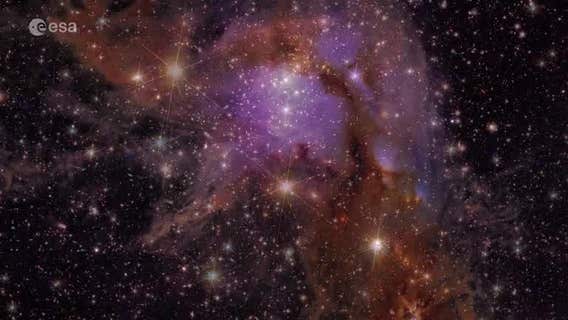Blue Origin launches all-female flight with Katy Perry, 5 others: 'Sisterhood'
Blue Origin launched an all-female space flight, which included Katy Perry, Gayle King and Lauren Sanchez, making history as the first all-female space crew since a solo flight in 1963.
Astronomers say new 'star' due to appear in night sky is 'late to the party'
Hurry up and wait. A new star is coming to the night sky - soon(ish).
New comet spotted: How to see SWAN25F
A new comet was officially designated as C/2025 F2 on April 8.
Confirmation hearing for Trump pick to lead NASA
The Trump administration wants to put Americans back on the moon and get them to Mars, but Trump's unconventional pick to lead NASA has to make his case to senators first. FOX's Rebekah Castor has more from his confirmation hearing.
Full moon 2025: When April’s ‘Pink Moon’ will hit the sky
Wondering when to catch the next full moon? Here’s when the sky will be offering some prime viewing this month.
Amazon sending fleet of satellites to space in step to provide internet for customers
Amazon said its Project Kuiper will provide high-speed, low-latency internet to almost any location on Earth.
Watch: Astronaut Suni Williams reunites with her dogs after 9 months in space
“Do you recognize me? Do you know who I am?” she asks as she cuddles her overjoyed dogs outside of her home.
FAA closes investigation of January SpaceX Starship explosion
The Federal Aviation Administration said its investigation into a January SpaceX test that ended in an explosion is closed.
Is Martian dust dangerous? New study reveals long-term health risks for astronauts
New research from the University of Colorado Boulder reveals how breathing in Martian dust could lead to serious health problems for astronauts, from lung damage to thyroid disease.
SpaceX Fram2 Mission: Historic launch of first human flight over Earth’s polar regions
SpaceX successfully launched another historic mission — this time, the Fram2, which will be the first human spaceflight to the Earth’s polar regions.
Were they stuck? NASA’s Starliner astronauts finally weigh in
Butch Wilmore and Suni Williams, in their first public comments since returning to Earth, tell FOX News about their thoughts when they found out their short test flight was going to be a lot longer.
See it: Partial solar eclipse puts on a show across New England, Europe
Only the far Northeastern U.S. and parts of eastern Canada were in the right spot to see at least part of the sun obscured by the moon as the sun rose Saturday morning.
Sunrise partial solar eclipse happens Saturday for parts of US
Cities along the I-95 corridor will see a partial eclipse, but it begins before sunrise for places such as Boston, New York, Philadelphia and Washington, which leaves just a few minutes to see this celestial show before it's over.
Ongoing geomagnetic storm increases chances to see Northern Lights again Wednesday
On Tuesday, aurora lights were seen as far south as Central Illinois. Northern lights are possible again on Wednesday as G2 (moderate) geomagnetic storming is forecast.
Watch: SpaceX spy satellite launch leaves otherworldly spiral in the sky
Monday’s SpaceX launch was carrying a classified satellite to space, but the secret payload was not the cause of an unusual glowing spiral seen in the skies of Europe.
How to look back on 10 billion years of cosmic history
The European Space Agency’s Euclid mission launched in 2023 with a goal of studying what is known as the "dark universe."
NJ man's lawsuit claims crew forced him out of plane bathroom, exposing his genitalia
A New Jersey man sued United Airlines and Homeland Security, claiming they forcibly removed him from a bathroom during a flight, exposing his genitalia while he was dealing with constipation.
Northern Lights likely across the north Saturday night amid Geomagnetic Storm Watch
A solar flare erupted from the sun on Friday and is zooming across space, forecast to reach Earth Saturday night and could trigger a geomagnetic storm upon arrival.
NASA spacecraft set for second close encounter with the sun—what it hopes to learn
NASA’s Parker Solar Probe is set for another close brush with the sun, reaching record speeds of 430,000 mph as it flies through the solar atmosphere. Scientists hope the mission will reveal new insights about the sun’s corona and the solar wind.
NASA astronauts delayed in space for 9 months won’t get overtime pay
NASA astronauts Suni Williams and Butch Wilmore spent nine months stuck in space after a Boeing Starliner failure. Despite the risks, they earned no hazard pay or overtime—just their standard government salary.





















